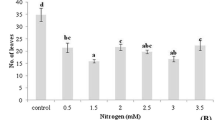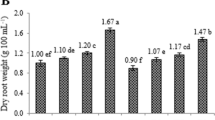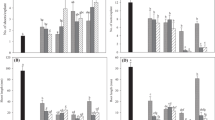Abstract
An efficient method for in vitro propagation of the bryophyte moss Plagiomnium cuspidatum (Hedw.) T.J. Kop is presented. Protocol optimization investigated media salt strength (quarter, third, or half-strength Murashige and Skoog; MS), sugar concentration (1 to 3% (w/v) sucrose), growth regulator content (presence of benzylaminopurine (BA) at 0–5 μM and napthaleneacetic acid (NAA) at 0–5 μM), and the addition of the phenylpropanoid biosynthesis inhibitor 2-aminoindan-2-phosphonic acid (AIP). Optimal media composition was determined to be half-strength MS with 2% (w/v) sucrose and 0.1 μM NAA. This method was then utilized to examine the effects of modified phenylpropanoid metabolism via application of AIP, an inhibitor of the first dedicated enzyme in phenylpropanoid biosynthesis, phenylalanine ammonia lyase (PAL). Treatment with AIP greatly reduced tissue browning and initiation of branching in P. cuspidatum and resulted in prolific production of straw to pale green-colored rhizoids. Treatment of plants with AIP in combination with the biosynthetic product of PAL, trans-cinnamic acid, was not able to fully recover the branching or browning phenotype, but several other phenolics, including p-coumaric acid and kaempferol, produced farther downstream in the biosynthetic pathway, were capable of partial recovery of the phenotype. Additionally, treatment with two indoleamines, melatonin and its biosynthetic precursor N-acetylserotonin, was also capable of partial recovery of the phenotype, showing greatly increased branching and increased browning of rhizoids. These results suggest that cross talk between phenylpropanoid and indoleamine metabolism is involved in bryophyte growth and development, beyond their traditional roles, leading to modified developmental outcomes.







Similar content being viewed by others
References
Alvarez A, Montesano M, Schmelz E, Ponce de León I (2016) Activation of shikimate, phenylpropanoid, oxylipins, and auxin pathways in Pectobacterium carotovorum elicitors-treated moss. Front Plant Sci 22:328
Arnao MB, Hernández-Ruiz J (2014) Melatonin: plant growth regulator and/or biostimulator during stress? Trends Plant Sci 19:789–797
Ashton NW, Grimsley NH, Cove DJ (1979a) Analysis of gametophytic development in the moss, Physcomitrella patens, using auxin and cytokinin resistant mutants. Planta 144:427–435
Ashton NW, Cove SJ, Featherstone DR (1979b) The isolation and physiological analysis of mutants of the moss, Physcomitrella patens, which over-produces gametophores. Planta 144:437–442
Bajwa VS, Shukla MR, Sherif SM, Murch SJ, Saxena PK (2015) Identification and characterization of serotonin as an anti-browning compound of apple and pear. Postharvest Biol Technol 110:183–189
Bennett TA, Liu MM, Aoyama T, Bierfreund NM, Braun M, Coudert Y, Dennis RJ, O’Connor D, Wang XY, White CD, Decker EL, Reski R, Harrison CJ (2014) Plasma membrane-targeted PIN proteins drive shoot development in a moss. Curr Biol 24:2776–2785
Boudet A-M (2007) Evolution and current status of research in phenolic compounds. Phytochemistry 68:2722–2735
Brown DE, Rashotte AM, Murphy AS, Normanly J, Tague BW, Peer WA, Taiz L, Muday GK (2001) Flavonoids act as negative regulators of auxin transport in vivo in Arabidopsis. Plant Physiol 126:524–535
Byeon Y, Back K (2016) Melatonin production in Escherichia coli by dual expression of serotonin N-acetyltransferase and caffeic acid O-methyltransferase. Appl Microbiol Biotechnol 100:6683–6691
Byeon Y, Choi G-H, Lee HY, Back K (2015) Melatonin biosynthesis requires N-acetylserotonin methyltransferase activity of caffeic acid O-methyltransferase in rice. J Exp Bot 66:6917–6925
Byeon Y, Lee HY, Lee K, Park S, Back K (2014) Cellular localization and kinetics of the rice melatonin biosynthetic enzymes SNAT and ASMT. J Pineal Res 56:107–114
Coudert Y, Palubicki W, Ljung K, Novak O, Leyser O, Harrison CJ (2015) Three ancient hormonal cues co-ordinate shoot branching in a moss. elife 4:e06808
Cvikrová M, Malá J, Eder J, Hrubcová M, Vágner M (1998) Abscisic acid, polyamines and phenolic acids in sessile oak somatic embryos in relation to their conversion potential. Plant Physiol Biochem 36:247–255
Daku RM, Rabbi F, Buttigieg J, Coulson IM, Horne D, Martens G, Ashton NW, Suh DY (2016) PpASCL, the Physcomitrella patens anther-specific chalcone synthase-like enzyme implicated in sporopollenin biosynthesis, is needed for integrity of the moss spore wall and spore viability. PLoS One 11:e0146817
Dixon RA, Paiva NL (1995) Stress-induced phenylpropanoid metabolism. Plant Cell 7:1085–1097
Erland LAE, Mahmoud SS (2014) An efficient method for regeneration of lavandin (Lavandula × intermedia cv. “Grosso”). In Vitro Cell Dev Biol-Plant 50:646–654
Erland LAE, Murch SJ, Reiter RJ, Saxena PK (2015) A new balancing act: the many roles of melatonin and serotonin in plant growth and development. Plant Signal Behav 10:e1096469
Erland LAE, Chattopadhyay A, Jones AMP, Saxena PK (2016) Melatonin in plants and plant culture systems: variability, stability and efficient quantification. Front Plant Sci 6:1721
Erland LAE, Saxena PK, Murch SJ (2018) Melatonin in plant signalling and behaviour. Func Plant Biol 45:58–69
Gitz DC, Liu L, McClure JW (1998) Phenolic metabolism, growth and uv-b tolerance in phenylalanine ammonia-lyase-inhibited red cabbage seedlings. Phytochemistry 49:377–386
Gitz DC, Liu-Gitz L, McClure JW, Huerta AJ (2004) Effects of a PAL inhibitor on phenolic accumulation and UV-B tolerance in Spirodela intermedia (Koch.). J Exp Bot 55:919–927
Harrison CJ (2016) Auxin transport in the evolution of branching forms. New Phytol 2:545–551
Hassan S, Mathesius U (2012) The role of flavonoids in root–rhizosphere signalling: opportunities and challenges for improving plant–microbe interactions. J Exp Bot 63:3429–3444
Hudina M, Orazem P, Jakopic J, Stampar F (2014) The phenolic content and its involvement in the graft incompatibility process of various pear rootstocks (Pyrus communis L.). J Plant Physiol 171:76–84
Janas KM, Osiecka R, Zoń J (1998) Growth-retarding effect of 2-aminoindan-2-phosphonic acid on Spirodela punctata. J Plant Growth Regul 17:169–172
Jiménez VM (2005) Involvement of plant hormones and plant growth regulators on in vitro somatic embryogenesis. Plant Growth Regul 47:91–110
Jones AMP, Saxena PK (2013) Inhibition of phenylpropanoid biosynthesis in Artemisia annua L.: a novel approach to reduce oxidative browning in plant tissue culture. PLoS One 8:e76802
Jones AMP, Shukla MR, Chattopadhyay A, Zón J, Saxena PK (2013) Investigating the roles of phenylpropanoids in the growth and development of Zea mays L. Vitro Cell Dev Biol-Plant 49:765–772
Jones AMP, Chattopadhyay A, Shukla M, Zón SPK (2012) Inhibition of phenylpropanoid biosynthesis increases cell wall digestibility, protoplast isolation, and facilitates sustained cell division in American elm (Ulmus americana). BMC Plant Biol 12:75
Kang K, Park S, Kim YS, Lee S, Back K (2009) Biosynthesis and biotechnological production of serotonin derivatives. Appl Microbiol Biotechnol 83:27–34
Krishna H, Sairam RK, Singh SK, Patel VB, Sharma RR, Grover M, Nain L, Sachdev A (2008) Mango explant browning: effect of ontogenic age, mycorrhization and pre-treatments. Sci Hortic 118:132–138
Laukkanen H, Rautiainen L, Taulavuori E, Hohtola A (2000) Changes in cellular structures and enzymatic activities during browning of Scots pine callus derived from mature buds. Tree Physiol 20:467–475
Lee HY, Byeon Y, Lee K, Lee HJ, Back K (2014) Cloning of Arabidopsis serotonin N-acetyltransferase and its role with caffeic acid O-methyltransferase in the biosynthesis of melatonin in vitro despite their different subcellular localizations. J Pineal Res 57:418–426
Liang C, Li A, Yu H, Li W, Liang C, Guo S, Zhang R, Chu C (2017) Melatonin regulates root architecture by modulating auxin response in rice. Front Plant Sci 8. https://doi.org/10.3389/fpls.2017.00134
Liu B, Lei C, ** J, Li S, Zhang YS, Liu WQ (2015) Physiological responses of two moss species to the combined stress of water deficit and elevated nitrogen deposition. I. Secondary metabolism. Int J Plant Sci 176:446–457
Ljung K (2013) Auxin metabolism and homeostasis during plant development. Development 140:943–950
Macoy DM, Kim W-Y, Lee SY, Kim MG (2015) Biosynthesis, physiology, and functions of hydroxycinnamic acid amides in plants. Plant Biotechnol Rep 9:269–278
Mithöfer A, Boland W (2012) Plant defense against herbivores: chemical aspects. Annu Rev Plant Biol 63:431–450
Murashige T, Skoog F (1962) A revised medium for rapid growth and bioassays with tobacco tissue cultures. Physiol Plant 15:473–497
Murch SJ, Campbell SSB, Saxena PK (2001) The role of serotonin and melatonin in plant morphogenesis: regulation of auxin-induced root organogenesis in in vitro-cultured explants of St. John’s wort (Hypericum perforatum L.). Vitro Cell Dev Biol-Plant 37:786–793
Nybakken L, Keski-Saari S, Falck MA, Julkunen-Tiitto R (2007) Restoration of secondary metabolism in birch seedlings relieved from PAL-inhibitor. Trees 21:273–281
Nyman LP, Cutter EG (1981) Auxin-cytokinin interaction in the inhibition, release and morphology of gametophore buds of Plagiomnium cuspidatum from apical dominance. Can J Bot 59:750–762
Park S, Byeon Y, Back K (2013) Functional analyses of three ASMT gene family members in rice plants. J Pineal Res 55:409–415
Peer WA, Murphy AS (2007) Flavonoids and auxin transport: modulators or regulators? Trends Plant Sci 12:556–563
Pelagio-Flores R, Ortíz-Castro R, Méndez-Bravo A, Macías-Rodríguez L, López-Bucio J (2011) Serotonin, a tryptophan-derived signal conserved in plants and animals, regulates root system architecture probably acting as a natural auxin inhibitor in Arabidopsis thaliana. Plant Cell Physiol 52:490–508
Reiter RJ, Mayo JC, Tan D-X, Sainz RM, Alatorre-Jimenez M, Qin L (2016) Melatonin as an antioxidant: under promises but over delivers. J Pineal Res 61:253–278
Roberts AW, Roberts EM, Haigler CH (2012) Moss cell walls: structure and biosynthesis. Front Plant Sci 3:166
Rowntree JK, Pressel S, Ramsay MM, Sabovljevic A, Sabovljevic M (2011) In vitro conservation of European bryophytes. In Vitro Cell Dev Biol-Plant 47:55–64
Sabovljević A, Sabovljevic M, Grubisic D, Konjevic R (2005) The effect of sugars on development of two moss species (Bryum argenteum and Atrichum Undulatum) during in vitro culture. Belg J Bot 138:79–84
Sabovljević M, Vujičić M, Pantović J, Sabovljević A (2014a) Bryophyte conservation biology: in vitro approach to the ex situ conservation of bryophytes from Europe. Plant Biosyst - Int J Deal Asp Plant Biol 148:857–868
Sabovljević M, Vujičić M, Sabovljević A (2014b) Plant growth regulators in bryophytes. Bot Serbica 38:99–107
Sarkar P, Bosneaga E, Auer M (2009) Plant cell walls throughout evolution: towards a molecular understanding of their design principles. J Exp Bot 60:3615–3635
Singleton VL, Rossi JA (1965) Colorimetry of total phenolics with phosphomolybdic-phosphotungstic acid reagents. Am J Enol Vitic 16:144–158
Tóth K, Haapala T, Hohtola A (1994) Alleviation of browning in oak explants by chemical pretreatments. Biol Plant 36:511–517
Uchendu EE, Paliyath G, Brown DCW, Saxena PK (2011) In vitro propagation of North American ginseng (Panax quinquefolius L.). In Vitro Cell Dev Biol-Plant 47:710–718
Vogt T (2010) Phenylpropanoid biosynthesis. Mol Plant 3:2–20
Yao K, Luca VD, Brisson N (1995) Creation of a metabolic sink for tryptophan alters the phenylpropanoid pathway and the susceptibility of potato to Phytophthora infestans. Plant Cell 7:1787–1799
Zhang N, Sun Q, Li H, Li X, Cao Y, Zhang H, Li S, Zhang L, Qi Y, Ren S, Zhao B, Guo YD (2016) Melatonin improved anthocyanin accumulation by regulating gene expressions and resulted in high reactive oxygen species scavenging capacity in cabbage. Front Plant Sci 23:197
Zoń J, Amrhein N (1992) Inhibitors of phenylalanine ammonia-lyase: 2-aminoindan-2-phosphonic acid and related compounds. Liebigs Ann Chem 1992:625–628
Funding
The authors gratefully acknowledge the financial support of this work by the National Sciences and Engineering Research Council (NSERC) of Canada [grant number 46741] and the Gosling Research Institute of Plant Preservation (GRIPP).
Author information
Authors and Affiliations
Corresponding author
Additional information
Editor: Wagner Campos Otoni
Rights and permissions
About this article
Cite this article
Chattopadhyay, A., Erland, L.A.E., Jones, A.M.P. et al. Indoleamines and phenylpropanoids modify development in the bryophyte Plagiomnium cuspidatum (Hedw.) T.J. Kop. In Vitro Cell.Dev.Biol.-Plant 54, 454–464 (2018). https://doi.org/10.1007/s11627-018-9904-3
Received:
Accepted:
Published:
Issue Date:
DOI: https://doi.org/10.1007/s11627-018-9904-3




